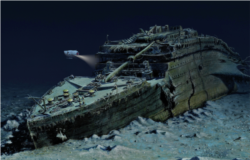People have been diving down to the Titanic’s wreckage for around 35 years. But so far, no one has found human remains, the company that owns rights to the wreckage says.
Now the company, RMS Titanic Inc., is planning for a new expedition that is raising concerns. It wants to send a team to collect the ship’s famous radio equipment and prepare it to be shown in public. But some are questioning the plan, saying the world’s most famous shipwreck could still hold remains of passengers and crew.
The disagreement is part of a larger debate over how the Titanic’s victims should be remembered, honored and respected.
Background
The Titanic was traveling from England to New York in 1912 when it hit an iceberg. It sank in the North Atlantic. Over 1,500 people died in the disaster. The wreck was discovered in 1985.
RMS Titanic Inc. owns the salvage rights, or rights to what is left, of the Titanic. The company is the court-recognized caretaker of objects from the Titanic. It oversees thousands of items including silverware, china and gold coins.
The company wants to exhibit, or publicly show, the ship’s Marconi wireless telegraph machine. The telegraph broadcast the ship’s emergency calls, which helped save the lives of hundreds of people in lifeboats.
Court case
Lawyers for the U.S. government are taking part in a court battle to block the planned dive. They point to experts who say human remains could still be there. And they say the company fails to consider that possibility in its dive plan.
Paul Johnston is an expert at the Smithsonian’s National Museum of American History. “Fifteen hundred people died in that wreck,” he told The Associated Press. “You can’t possibly tell me that some human remains aren’t buried deep somewhere where there are no currents.”
Current is a term that means a continuous movement of water or air.
An unmanned submersible, a kind of underwater vehicle, would need to enter the wreckage to bring back the telegraph machine. A special tool would be used to remove loose dirt and sand, while robotic arms would cut electrical connections.
Over the years, explorers have sent other unmanned vehicles into parts of the ship. During his 2001 expedition, film director James Cameron examined the area that holds the telegraph equipment, according to court documents filed by the company.
RMS Titanic Inc. says any existing human remains would likely have been seen after around 200 dives.
David Gallo is an oceanographer and company adviser. “There’s an unwritten rule that, should we see human remains, we turn off the cameras and decide what to do next,” Gallo said. But he added that the remains of those who died likely disappeared decades ago.
In May, a federal judge in Norfolk, Virginia, approved the expedition.
But the U.S. government brought a legal case in June to stop it, claiming the plan would violate federal law and an agreement with Britain. The agreement recognizes the wreck as a memorial site. U.S. lawyers argue the agreement restricts entry into the wreck. The restriction aims to make sure that the hull, artifacts and “any human remains” are undisturbed.
The president of RMS Titanic Inc., Bretton Hunchak, told the AP the government’s position is based on emotion rather than science. “Issues like this are used simply to raise public support,” Hunchak said.
“This company has always treated the wreck ... with reverence and respect,” Hunchak added. “And that doesn’t change whether in fact human remains could possibly exist.”
Archaeologists who filed court statements supporting the government’s case said they believe there must be human remains. They have questioned those refusing to accept that possibility.
The Smithsonian’s Johnston wrote to the court that remains could still be found in some areas lacking oxygen. But he said the company does not want “anyone to be thinking about human remains. They want people to think, ‘Oh cool. I have new artifacts to show the public.’”
I'm John Russell.
Ben Finley reported on this story for the Associated Press. John Russell adapted it for Learning English. Bryan Lynn was the editor.
_____________________________________________________________
Words in This Story
iceberg – n. a very large piece of ice floating in the ocean
expedition – n. a journey especially by a group of people for a specific purpose (such as to explore a distant place or to do research)
hull – n. the main part of a ship or boat : the deck, sides, and bottom of a ship or boat
undisturbed – adj. not interrupted or changed in any way
reverence – n. honor or respect that is felt for or shown to (someone or something)
archaeologist – n. : an expert in a science that deals with past human life and activities by studying the bones, tools, etc., of ancient people
artifact – n. an object (such as a tool or weapon) that was made by people in the past
We want to hear from you. Write to us in the Comments Section.










